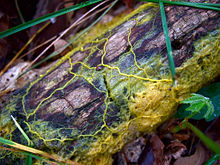Swarm intelligence/Slime mold
Appearance

Slime Mold create a swarm of Unicellular Organisms (BBC Video on Youtube[1]). It is obvious that the individuals in a swarm do not have an "intelligence" as unicellular organisms. But the swarm is able to determine the shortest path for food supply of the community[2]. This learning resource introduces the concept of swarm intelligence on the level of unicellular systems.
Videos
[edit | edit source]- Slime molds solving the shortest path problem (without comments) 92h Time lapse
- BBC Video on Youtube about Slime Mold[3]
- Lens of Time: Slime Lapse by bioGraphic[4] (with Comments) for food supply of the community of unicellular organisms
- The Physarum Experiments, Study No.024: Interspecies Encounter - Competition between two species.
Learning Task
[edit | edit source]- Watch the videos, explore literature and explain, how the slime mold transport food in network and how the other swarm organisms benefit from the swarm behaviour!
- What would happen, if only the unicellular organisms, that have direct access to the food source, would benefit? What is the evolutionary benefit of the swarm behaviour?
- Can you identify disadvantages of that strategy!
- Swarm molds create a food supply network for the swarm. Where do you find other networks in nature, technical environments or social systems, that create same network structures to support the members of the community?
References
[edit | edit source]- ↑ Mould Time-lapse - The Great British Year: Episode 4 Preview - BBC One (2013) - https://www.youtube.com/watch?v=GY_uMH8Xpy0
- ↑ Slime mold solving maze - Youtube Video by Daniel Brunner (2010) - https://www.youtube.com/watch?v=5UfMU9TsoEM
- ↑ Slime Mold BCC - 2013 (accessed 2017/10/27) - https://www.youtube.com/watch?v=GY_uMH8Xpy0
- ↑ Lens of Time: Slime Lapse by GeoGraphic Magazine published on Youtube (2016) - https://www.youtube.com/watch?v=olCEGsKWQ3c
